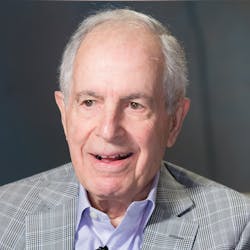Gambino’s career focused on testing quality and patient safety
Salvadore Raymond “Ray” Gambino, MD, 1926-2022, passed away on January 1, 2022, after a brief illness. He was a remarkable person and one of the leading figures in the development of modern clinical laboratory medicine.
He also played a critical role in the launch of Medical Laboratory Observer (MLO) and Clinical Laboratory Reference (CLR), where he was clinical editor from 1969-1978.
Storyteller
To teach, Gambino was a keen storyteller. In a March 20, 1976, op-ed in The New York Times he wrote, “During my professional career, I have been responsible for three serious errors: a wrong unit of blood, a wrong autopsy, and a wrong gas (carbon monoxide). How could anyone make such errors? I don’t have the final answer, but I think the following case histories will tell something about the genesis of error.”
One lesson from the case studies he presented is we see what we expect to see. Another lesson is that despite multiple check points, everyone assumes someone else checked first. “Two heads aren’t always better than one,” Gambino wrote.
These stories of errors and “near misses” help us learn and create solutions to ensure patient safety and reliable laboratory services. Gambino concluded his The New York Times piece with advice to always place safety first, “Safety will have to come before cost effectiveness.”
Lab leader
Gambino was a leader in quality for clinical laboratories throughout his career. He delivered innumerable seminars on laboratory operations and quality throughout the United States. He was Editor-in-Chief of American Society for Clinical Pathology (ASCP) Check Sample, a self-education program, from 1969-1992. Gambino started his own newsletter “Lab Report” in 1979 and was its editor through 1998.
In 1990, Gambino received the ASCP Ward Burdick Award for Distinguished Service to Pathology. In 2009, he was designated as a Mastership, an honor for distinguished ASCP members who have made significant contributions to the field of pathology and laboratory medicine and to ASCP.
With Robert Galen, MD, Gambino wrote Beyond Normality: The Predictive Value and Efficiency of Medical Diagnoses. This classic book was instrumental in the industrywide adoption of the concepts of sensitivity, specificity, and predictive values.
Gambino’s career began after he graduated from Antioch College in 1948 and University of Rochester Medical School in 1952.
But it was during his tenure (1961-1969) as the laboratory director at Englewood (NJ) Hospital that Gambino shocked the hospital’s medical staff by restricting the ordering of tests he considered inappropriate. He offered unlimited consultations to help guide appropriate laboratory utilization. His model was, “one clinician and one patient at a time.”
He held numerous other prestigious roles in laboratory management:
- Director of Clinical Chemistry, Presbyterian Hospital, New York, NY (1969-1978)
- Director of Laboratories and Chief Pathologist, St. Luke’s Hospital Center New York, NY (1978-1980)
- Director of Laboratories and Chief Pathologist, St. Luke’s-Roosevelt Hospital Center New York, NY (1980-1983)
- Executive Vice President and Chief Medical Officer, MetPath (precursor of Quest Diagnostics) Teterboro, NJ (1983-1993), and Executive Vice President and Chief Medical Officer Emeritus, Quest Diagnostics (1994-2014)
Gambino trained many medical residents throughout his career, including some who went on to become industry leaders themselves, such as James Powell, MD, Founder of what became LabCorp; Paul Brown, MD, Founder of MetPath; and Joseph O’Brien, MetPath’s long-lasting Laboratory Director. Another resident, Richard Axel, MD, Professor at Columbia University Medical Center, was awarded the 2004 Nobel Prize in Physiology or Medicine.
Role at MLO
In addition to his work in the laboratory and teaching residents, Gambino also was involved in the founding of Medical Laboratory Observer.
Gambino described his role in a 2009 article in MLO. He said two unexpected visitors from Medical Economics arrived at his office in Englewood, NJ. They wanted to create a controlled-circulation magazine for laboratorians.
“My immediate response was positive. Yes, we needed such a magazine, but their options were limited. They could either emulate Scientific American or emulate Medical Economics. Personally, I favored emulating Medical Economics.
I said, ‘Why not just create for laboratorians what you are now doing for practicing physicians?’
They did! Soon thereafter, I was asked if I would be willing join them as an editorial consultant for a new bi-monthly publication to be called Medical Laboratory Observer. I said, “Yes!”
Gambino was a force of nature full of ideas, explorations, and knowledge that directly influenced many lives. He was never afraid to raise his voice when he thought patient care could be improved. Gambino’s impact will last a long time and will always be associated with Quest Diagnostics’ top quality award, the Gambino Award. His long life was a novel full of stories with lessons that, when applied, improve patient safety and clinical laboratory testing and services. Thank you, Ray Gambino.
About the Author

Harvey W. Kaufman, MD
a board-certified pathologist, is Senior Medical Director at Quest Diagnostics. A 29-year veteran of Quest Diagnostics, Kaufman was an original and still active member of the Laboratory Working Group of the National Institute of Diabetes and Digestive and Kidney Diseases, NIH (formerly the National Kidney Disease Education Program).
